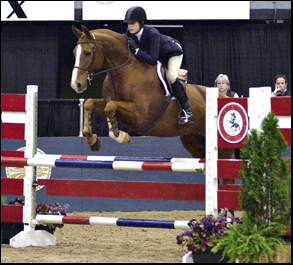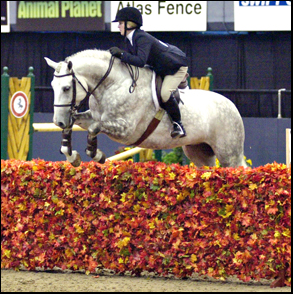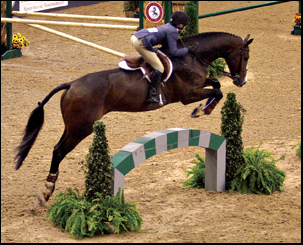The talented junior works her way to the top of the class this time.
It was a different kind of pressure this time.
Two weeks earlier,Kimberly McCormack had led from start to finish to win the Pessoa/USEF Medal Finals (Nov. 9, p. 30). But on Nov. 3, she capped a remarkable come-from-behind victory in the ASPCA Maclay Finals, completing the coveted Medal-Maclay double.
 “To do two of these in a row is a tremendous accomplishment,” said Missy Clark, who along with John Brennan and McCormack’s sister, Kristy, trained the 17-year-old to the win. “I was pretty confident that she was going to have a beautiful second round.”
“To do two of these in a row is a tremendous accomplishment,” said Missy Clark, who along with John Brennan and McCormack’s sister, Kristy, trained the 17-year-old to the win. “I was pretty confident that she was going to have a beautiful second round.”
McCormack’s first round in the Maclay, held during the Syracuse Sporthorse Invitational Tournament in Syracuse, N.Y., didn’t go quite as smoothly as her first trip in the Medal Finals.
She had a rail at a plank vertical, and the judges—George Morris and Linda Hough—put her in 10th going into the flat phase. But McCormack’s elegance and poise on the flat inspired them to move her up to fifth heading into Round 2.
And in the second round, McCormack, Clermont, N.J., sparkled while others faltered.
“Coming back, where she sat in fifth place, she was within striking distance for sure. All she needed to do was put in a consistent, smooth round, which she did beautifully,” Clark said.
“I never really thought about winning—that never works for me,” McCormack said. “I just wanted to go in there and lay it down and whatever happened, happened. I just thought about the course and riding my horse. It’s always surprising when everything all falls into place, so having it happen twice was incredible.”
What stood out about her second round was her quiet confidence and fluidity.
| Maclay Tidbits
• Judge George Morris is worried about where these talented riders will go from here. “This country always has an immense reservoir of talent. The key is what happens to people after they’re 18,” Morris said. “That’s where people get lost—they too quickly want to be professionals before they’re ready. But they should be apprentices to top professionals to learn more. I wasn’t a professional right away. I was 26 before I turned professional, and I had [won team silver at the 1960 Olympics and won the Grand Prix of Aachen in 1960]. And I was a lousy professional for the first few years. I had to ask for help with how to feed my horses.” • Trainer Karen Healey had a remarkable fall circuit with her students. At the Pessoa/USEF Medal Finals, she trained three top-10 finishers—Hannah Selleck (second), Tina DiLandri (third) and Shelby Wakeman (fourth). And at the ASPCA Maclay Finals, she helped Wakeman take third, and co-trained Carly Anthony (fourth) and Michelle Morris (sixth). • For judge Linda Hough, the riders weren’t the only impressive athletes at the Maclay Finals. “It’s such an amazing thing to sit there and watch these wonderful horses and what they do for these children,” Hough said. “There were so many moments that just made you proud to be a horsewoman. I enjoyed it immensely.” |
“What I liked best was her softness and her follow-through over the top of the jumps,” said Hough. “She doesn’t stick her hands in the neck—she has a nice, soft feel. And she’s got a classic position.
“She came in the ring fighting for the top. She didn’t start riding backwards—she was positive and relaxed. It was one of those moments that just happen, and it was great to be a part of it,” added Hough.
McCormack’s sister, Kristy, traveled from Belgium to help cheer her sister on in Syracuse.
“I’m so proud of her,” Kristy said of “Kimmy.” The sisters worked together to bring along Kimmy’s horse, Sundance, from a green horse to a seasoned equitation mount.
“We found him and made him up together,” Kristy said. “It’s been incredible to see how far he’s come. He came from a small barn, as a hunter—and not a very good one. The first day I rode him, I hated him. He was unbroke, with no flatwork, and spooked at everything. And then I jumped him the second day and fell in love with him. He was our project and investment. He went from a sale horse into this amazing animal.”
ADVERTISEMENT
After the Maclay, Kimmy traveled to Belgium with her sister, who works for Stephex Stables, a busy sales barn. Kimmy plans to spend two months there riding jumpers and broadening her horizons before returning for the Winter Equestrian Festival (Fla.). She has deferred college for a year and has one more junior year remaining.
Kimmy’s big move to the top of the field of 153 riders wasn’t the only drama of the day.
Emily Gardner, Tallahassee, Fla., led the pack after Round 1 (see sidebar for course description) with a lovely, flowing trip.
Just behind her were Maria Schaub, Holmdel, N.J., and Michelle Morris, La Canada, Calif. Elizabeth Lubrano, Glenmoore, Pa., stood in fourth.
In the flat phase, the standings shuffled. Gardner moved down to third, while Schaub took over the lead. Morris moved up to second, and Lubrano held onto fourth.
Jennifer Walters, Shelburne, Vt., made a big impression in the flat phase, moving up from 26th to 18th. Shelby Wakeman’s consistent and forward Round 1 trip had put her into ninth before the flat phase, where she stayed.
The flat phase involved simple walk, trot and canter both ways, with neither the extended trot nor the counter-canter called for.
Earlier, there were some surprises in Round 1, however.
Hannah Selleck, Thousand Oaks, Calif., who placed second behind Kimmy in the Medal Finals, rode tentatively over the first few fences in Round 1. Though she finished the course well, she wasn’t called back for the flat phase.
And Tina DiLandri, La Jolla, Calif., third in the Medal Finals, saw her chances at Maclay glory slip away when her horse landed in the middle of a triple bar in Round 1.
And then Round 2 really shook things up.
Wakeman, Westlake Village, Calif., really put the pressure on the top few with a smooth, elegant trip.
“I wasn’t really nervous because—coming back in ninth—I didn’t really have anything to lose,” said Wakeman, who eventually moved up to third overall.
“Sometimes it’s easier that way—you just go in and give your best,” said Karen Healey, who trains Wakeman. “It’s better to lose trying to win than to just not try and lose. She’s a fighter. It’s an unbelievable match with that horse—he’s got a little bit of a funny temperament, and you have to know how to deal with him.”
Lucy Davis and Mallory Olson both had trips with minor mistakes, and then Katherine Newman—coming back in sixth place—took herself out of the running with a long and weak distance to one oxer, and a deep distance and rail at a Swedish oxer.
Kimmy, returning fifth, laid down a very slick trip, negotiating the tight rollbacks with style and showing boldness where appropriate. Then it was up to the top four riders to meet her challenge.
Lubrano, 18, rode well, with a few less-than-perfect moments, but her performance was rewarded with second place overall.
“I thought I was a little deep to the second jump [a narrow, arched wall], and a little rough to the two-stride, but I was happy with it,” she said.
ADVERTISEMENT
Lubrano trains with Beacon Hill—Frank and Stacia Madden, Krista Freundlich and Max Amaya. When Lubrano’s horse was injured just before the Capital Challenge (Md.) in October, she had to borrow a horse from her sister, Jacqueline, who was sixth at Medal Finals.
“It’s all still overwhelming. In the first round of the Medal Finals, I really tried to give it my all, and it didn’t work out so well. So today I was just trying to do the best I could on the horse I was riding,” she said.
Gardner’s round started to suffer when she got close to the triple bar, and then she rode tentatively to a serpentine of Swedish oxers, making wide turns. She had a rail down at the second of the three Swedish oxers and finished fifth overall.
Morris’ second round lacked the confidence and positive attitude of her first, and her horse hung up a bit over a few of the fences. In the end, she was sixth.
So, it was all up to Schaub, the final rider to test. She tried an outside turn and angled back to an oxer at the third fence, but it backfired when her horse, I Toon, had the front rail down there. Schaub then found a deep distance to the triple bar, and a long, weak distance to the following Swedish oxer. The round dropped her to seventh at the end of the day and left Kimmy atop the pack.
Two Courses Test Them All
The Round 1 course for the ASPCA Maclay Finals tested every aspect of the 153 riders’ skills.
 They began with an opening circle behind a tight dotted line. The first fence, an oxer out of the corner, was off a tight approach because of the limited space, and the riders had to get a good rhythm and pace
They began with an opening circle behind a tight dotted line. The first fence, an oxer out of the corner, was off a tight approach because of the limited space, and the riders had to get a good rhythm and pace
established right away if they wanted to jump it well.
A bending line to the left led to fence 2, a solid, wingless wall jump covered in red-and-orange ivy. It stood out but didn’t cause too many problems.
Then, a long bending five strides carried them to a scopey oxer-oxer one-stride combination along the wall of the ring. Riders had to jump the wall carefully, then go forward again to make the distance to the combination work.
Riders cantered around the end of the ring to the most influential jump on the course, a narrow, arched wall. With no wings, filler or ground line, this jump opened quite a few horses’ eyes. Riders had to choose whether to approach the wall from an angle directly out of the corner, or to go around a vertical and take a longer, more direct route to the fence.
If they rode the angled line to the wall, they then went in a direct six strides to a Swedish oxer. If they went the long way to the wall, they completed a bending seven-stride line to the oxer. In a straight line after the oxer was a vertical, set either a tight four or long three strides away.
They then rolled back out of the corner of the ring and made a sharp turn to the right to a triple bar, which was followed in a bending five strides to a vertical-oxer-vertical triple combination. They then cantered around the end of the ring to a vertical of wavy blue planks, which spooked more than a few horses. A bending line of seven or eight strides led to another Swedish oxer.
“We were each able to design one jump, and I designed the wall, which proved to be difficult, but I think it was a good test,” Hough said. “George did the pretty ivy jump. I think that the course in the morning was a little harder than it was in the afternoon, but we didn’t want to play down to the group.”

For Round 2, the 18 riders Hough and Morris asked to see after the flat phase jumped a narrow wall along the ring wall, then cantered around the end of the ring to the same narrow arched wall, this time set in an inviting angle out of the corner.
They then negotiated a tight rollback to the right over an oxer, and proceeded around the end of the ring again to another solid ivy wall, this time green. A bending four strides led to a double of oxers with a long one stride between them, followed by a tight three strides to a vertical.
They cantered around the end of the ring and came out of the corner over a narrow triple bar, and then a bending line left to a Swedish oxer. This started a serpentine across the width of the ring over three Swedish oxers, where the riders could show off a little boldness. Then, they cantered down the length of the ring to a delicate two-stride combination they jumped a tight two-stride combination of verticals to finish.
Molly Sorge














